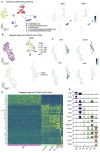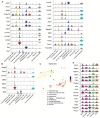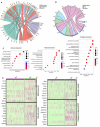This is a preprint.
Transcriptomic profiling of Schlemm's canal cells reveals a lymphatic-biased identity and three major cell states
- PMID: 37886472
- PMCID: PMC10602040
- DOI: 10.1101/2023.08.31.555823
Transcriptomic profiling of Schlemm's canal cells reveals a lymphatic-biased identity and three major cell states
Update in
-
Transcriptomic profiling of Schlemm's canal cells reveals a lymphatic-biased identity and three major cell states.Elife. 2024 Oct 18;13:RP96459. doi: 10.7554/eLife.96459. Elife. 2024. PMID: 39422453 Free PMC article.
Abstract
Schlemm's canal (SC) is central in intraocular pressure regulation but requires much characterization. It has distinct inner and outer walls, each composed of Schlemm's canal endothelial cells (SECs) with different morphologies and functions. Recent transcriptomic studies of the anterior segment added important knowledge, but were limited in power by SEC numbers or did not focus on SC. To gain a more comprehensive understanding of SC biology, we performed bulk RNA sequencing on C57BL/6J SC, blood vessel, and lymphatic endothelial cells from limbal tissue (~4500 SECs). We also analyzed mouse limbal tissues by single-cell and single-nucleus RNA sequencing (C57BL/6J and 129/Sj strains), successfully sequencing 903 individual SECs. Together, these datasets confirm that SC has molecular characteristics of both blood and lymphatic endothelia with a lymphatic phenotype predominating. SECs are enriched in pathways that regulate cell-cell junction formation pointing to the importance of junctions in determining SC fluid permeability. Importantly, and for the first time, our analyses characterize 3 molecular classes of SECs, molecularly distinguishing inner wall from outer wall SECs and discovering two inner wall cell states that likely result from local environmental differences. Further, and based on ligand and receptor expression patterns, we document key interactions between SECs and cells of the adjacent trabecular meshwork (TM) drainage tissue. Also, we present cell type expression for a collection of human glaucoma genes. These data provide a new molecular foundation that will enable the functional dissection of key homeostatic processes mediated by SECs as well as the development of new glaucoma therapeutics.
Figures







References
-
- Tham Y. C. et al., Global prevalence of glaucoma and projections of glaucoma burden through 2040: a systematic review and meta-analysis. Ophthalmology 121, 2081–2090 (2014). - PubMed
Publication types
Grants and funding
LinkOut - more resources
Full Text Sources
